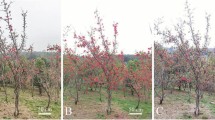Abstract
To examine the effect of stigma position and size on seed productivity through pollination efficiency in radish, the numbers of self and cross pollen grains on the stigmas and the seed productivity under insect-pollination were compared among four bred lines. Lines with a small stigma or a high stigma relative to the anthers on long stamens tended to receive fewer self and total (self + cross) pollen grains but showed a higher cross-pollination percentage (ratio of cross pollen grains to total pollen grains on stigmas) than those with a large stigma or a lower stigma. Additionally, a higher cross-pollination percentage was associated with a higher outcrossing percentage. This result suggests that variations in the two stigma traits affect the outcrossing percentage via the cross-pollination percentage. Therefore, it should be possible to prevent loss of F1 purity by selecting new parental lines with floral morphology that favors cross-pollination percentage.








Similar content being viewed by others
References
Anderson S (1996) Floral variation in Saxifraga granulata: phenotypic selection, quantitative genetics and predicted response to selection. Heredity 77:217–223. doi:10.1038/hdy.1996.127
Bateman AJ (1955) Self-incompatibility systems in angiosperms. (III) Cruciferae. Heredity 6:285–310. doi:10.1038/hdy.1952.40
Bradshaw HD, Schemske DW (2003) Allele substitution at a flower colour locus produces a pollinator shift in monkeyflowers. Nature 426:176–178. doi:10.1038/nature02106
Campbell DR, Waser NM, Price MV (1994) Indirect selection of stigma position in Ipomopsis aggregata via a genetically correlated trait. Evol Int J Org Evol 48:55–68. doi:10.2307/2410003
Darwin C (1859) On the origin of species by means of natural selection. J Murray, London
Horisaki A, Niikura S (2008) Developmental and environmental factors affecting level of self-incompatibility response in Brassica rapa L. Sex Plant Reprod 21:123–132. doi:10.1007/s00497-008-0071-2
Horisaki A, Tanaka N, Niikura S (2003) The effectiveness of insect-pollination test to evaluate the level of self-incompatibility and their genetic analysis in radish (Raphanus sativus L.). Theor Appl Genet 107:1009–1013. doi:10.1007/s00122-003-1256-6
Ishii HS (2006) Flower constancy of pollinators. Ecol Soc Jpn 56:230–239 In Japanese with English title
Johnson SD, Midgley JJ (2001) Pollination by monkey beetle (Scarabaeidae: Hopliini): do color and dark centers of flowers influence alighting behavior? Environ Entomol 30:861–868
Kobayashi K, Horisaki A, Niikura S, Ohsawa R (2006) Inter-accession variation in floral morphology in radish (Raphanus sativus L.). Euphytica 152:87–97. doi:10.1007/s10681-006-9181-9
Kobayashi K, Horisaki A, Niikura S, Ohsawa R (2007) Diallel analysis of floral morphology in radish (Raphanus sativus L.). Euphytica 158:153–165. doi:10.1007/s10681-007-9439-x
Lee TN, Snow AA (1998) Pollinator preferences and the persistence of crop genes in wild radish populations (Raphanus raphanistrum, Brassicaceae). Am J Bot 85:333–339. doi:10.2307/2446325
Namai H, Ohsawa R, Ushita N (1992) Independent evolution of automatic self-pollination ability and self-fertility in Raphanus sativus L. and Brassica juncea. In: Batigina (ed) Embryology and seed reproduction. Nauka, St. Petersburg, pp 387–388
Niikura S (2007) Genetic analysis of reproductive characteristics for the breeding of cruciferous vegetables. Breed Res (Ikusyugaku Kenkyu) 9:153–160 In Japanese
Niikura S, Matsuura S (1997) Genomic sequence and expression of S-locus gene in radish (Raphanus sativus L.). Sex Plant Reprod 10:250–252. doi:10.1007/s004970050094
Niikura S, Matsuura S (1998) Identification of self-incompatibility alleles (S) by PCR-RFLP in radish (Raphanus sativus L.). Euphytica 102:379–384. doi:10.1023/A:1018313801728
Niikura S, Matsuura S (1999) Genetic variation of the S-alleles and level of self-incompatibility in Japanese cultivated radish (Raphanus sativus L.). Breed Res (Ikusyugaku Kenkyu) 1(21):1–220 In Japanese with English abstract
Nishihiro J, Washitani I, Thomson JD, Thomson BA (2000) Patterns and consequences of stigma height variation in a natural population of a distylous plant, Primula sieboldii. Funct Ecol 14:502–512. doi:10.1046/j.1365-2435.2000.00449.x
Ohsawa R, Namai H (1988) Cross-pollination efficiency of insect pollinators (shimahanaabu, Eristalis cerealis) in rapeseed, Brassica napus L. Jpn J Breed 38:91–102 In Japanese with English abstract
Schemske DW, Bradshaw HD Jr (1999) Pollinator preference and the evolution of floral traits in monkey flowers (Mimulus). Proc Natl Acad Sci USA 96:11910–11915. doi:10.1073/pnas.96.21.11910
Syafaruddin HorisakiA, Niikura S, Yoshioka Y, Ohsawa R (2006) Effect of floral morphology on pollination in Brassica rapa L. Euphytica 149:267–272. doi:10.1007/s10681-005-9074-3
Yoshioka Y, Horisaki A, Kobayashi K, Syafaruddin NiikuraS, Ninomiya S, Ohsawa R (2005) Intraspecific variation in the ultraviolet colour proportion of flowers in Brassica rapa L. Plant Breed 124:551–556. doi:10.1111/j.1439-0523.2005.01132.x
Young HJ, Stanton ML (1990) Influences of floral variation on pollen removal and seed production in wild radish. Ecology 71:536–547. doi:10.2307/1940307
Acknowledgments
We thank Dr. S. W. Bang, an associate professor in the Faculty of Agriculture, Utsunomiya University, for providing the tetraploid radish ‘BmR’, and Dr. S. Matsuura of the Tohoku Seed Company for valuable comments on this study. This work was supported by a grant for a Research Project for Utilizing Advanced Technology in Agriculture, Forestry and Fisheries from the Ministry of Agriculture, Forestry and Fisheries of Japan and by a Grant-in-Aid for Exploratory Research from the Japan Society for the Promotion of Science.
Author information
Authors and Affiliations
Corresponding author
Rights and permissions
About this article
Cite this article
Kobayashi, K., Horisaki, A., Niikura, S. et al. Floral morphology affects seed productivity through pollination efficiency in radish (Raphanus sativus L.). Euphytica 168, 263–274 (2009). https://doi.org/10.1007/s10681-009-9944-1
Received:
Accepted:
Published:
Issue Date:
DOI: https://doi.org/10.1007/s10681-009-9944-1




